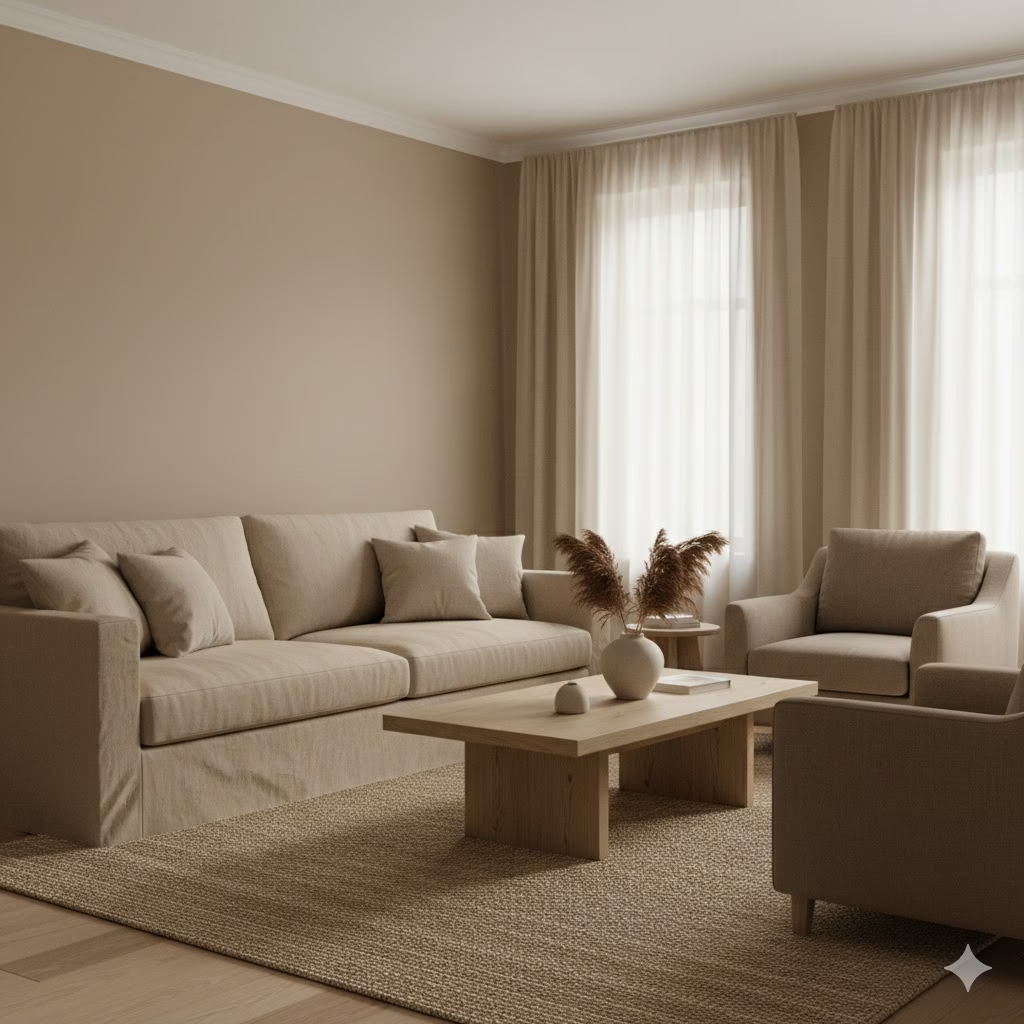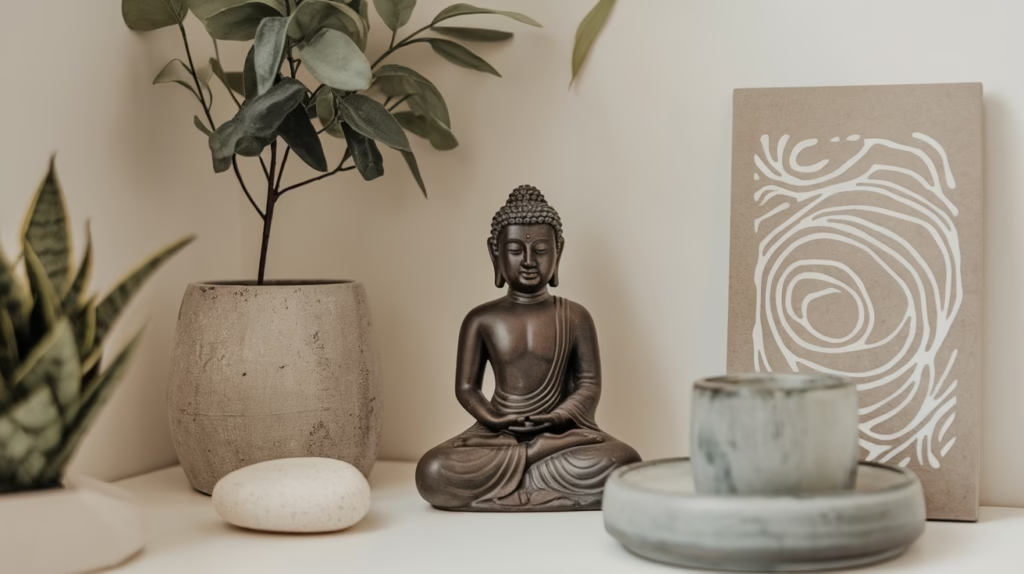Discover the guideline for a happier home by learning how to create a Chill Kid Space a dedicated spot for children to self-regulate, unwind, and process big feelings. This unique zone is designed with soothing colors, gentle lights, and sensory tools to help kids find their calm. Most importantly, it’s essential to remember that this space is a supportive sanctuary, never to be used as a punishment area or for forced time-outs. Give your child the gift of emotional empowerment with their own personal retreat.
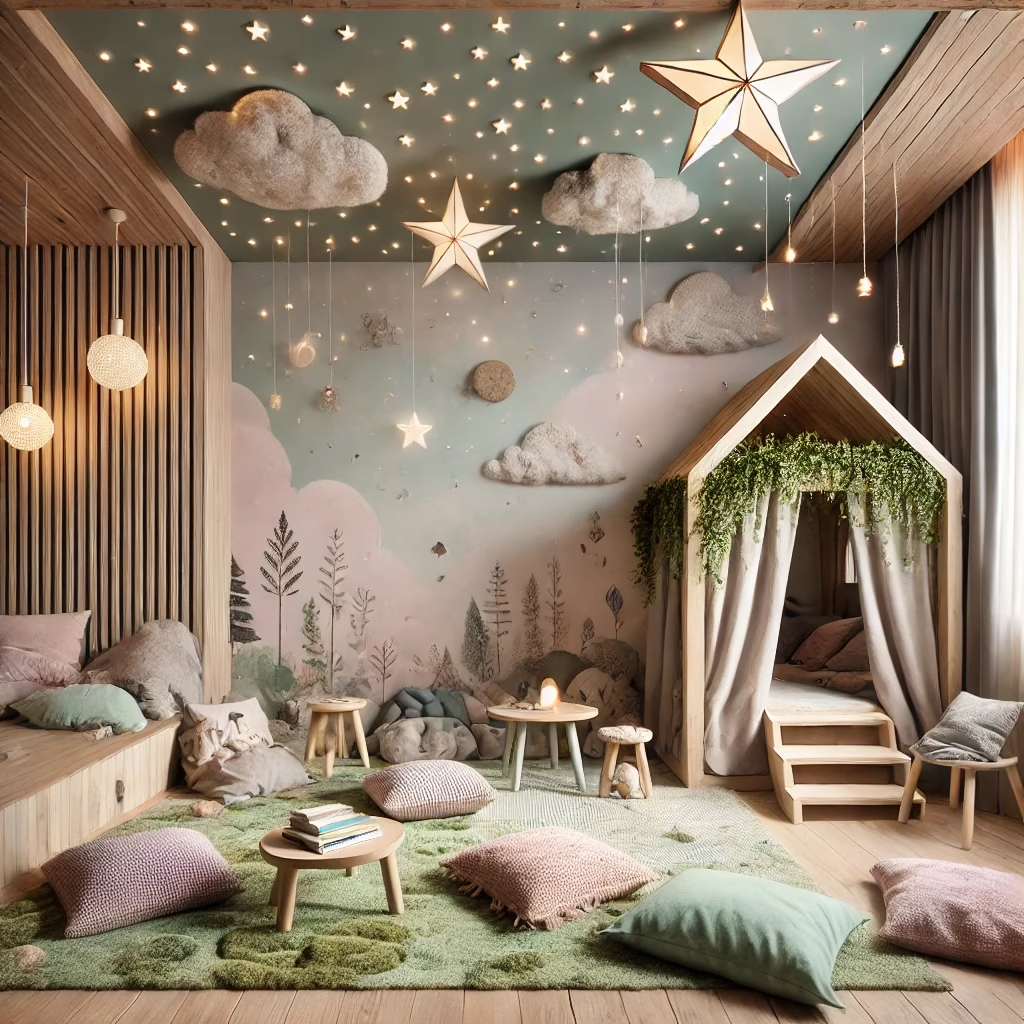
Introduction: Making a Peaceful Chill Kid Space
Life today moves fast. Even children can feel stressed out. School, games, new friends—it all adds up! What if your child had a quiet, special spot just for them? A place where they could slow down and feel better?
This is the idea behind the Chill Kid Space (you can also call it a Calm Corner or Zen Zone). It is a safe place made for kids to handle their feelings and find calm inside. We are not making a sterile “quiet corner.” We are building a vibrant, yet peaceful, area. It’s a comfortable escape from a busy day. It’s a spot where big feelings are okay. This guide will walk you through every step. You will learn how to make this great space in your home.
1. Setting the Scene: Colors and Light for a Chill Kid Space

The look of a Chill Kid Space is the first step to peace. You must use colors and light that tell the brain, “Time to relax!”
The Best Calming Colors
When you pick paint or fabric, stay away from bright, hot colors like red or neon yellow. These colors can make kids hyper. Instead, choose cool, soft colors:
- Nature Colors: Gentle blues (like the sky), soft greens (like plants), and calm grays are great choices. These colors feel like being outside. They make kids feel safe and stable.
- Muted Tones: Pale purple, soft pink, and cream are good for walls or big furniture. They help keep the space uncluttered and calm.
- Keep It Simple: Use your main calm color for most of the space. Then, use a second soft color for chairs or rugs. This keeps the look balanced and easy on the eyes.
Soft and Welcoming Lighting
Bright overhead lights can be harsh and make stress worse. Focus on creating a warm, gentle light instead.
- Dimmers are Key: If you can, put a dimmer on the main light switch. This is the best way to change the light level based on how your child is feeling.
- Magical Lights: Use battery-powered fairy lights. Drape them inside a tent or along a shelf. Their soft sparkle is comforting and makes the space feel special.
- Fun Focus: Add a lava lamp. Its slow, swirling motion is very soothing to watch. A small color-changing LED light that moves slowly through blues and greens is also calming.
- Soft Daylight: Use thin, sheer curtains. They let in natural light but stop harsh glares. This fills the area with soft, gentle light.
2. Sounds for Stress-Free Moments
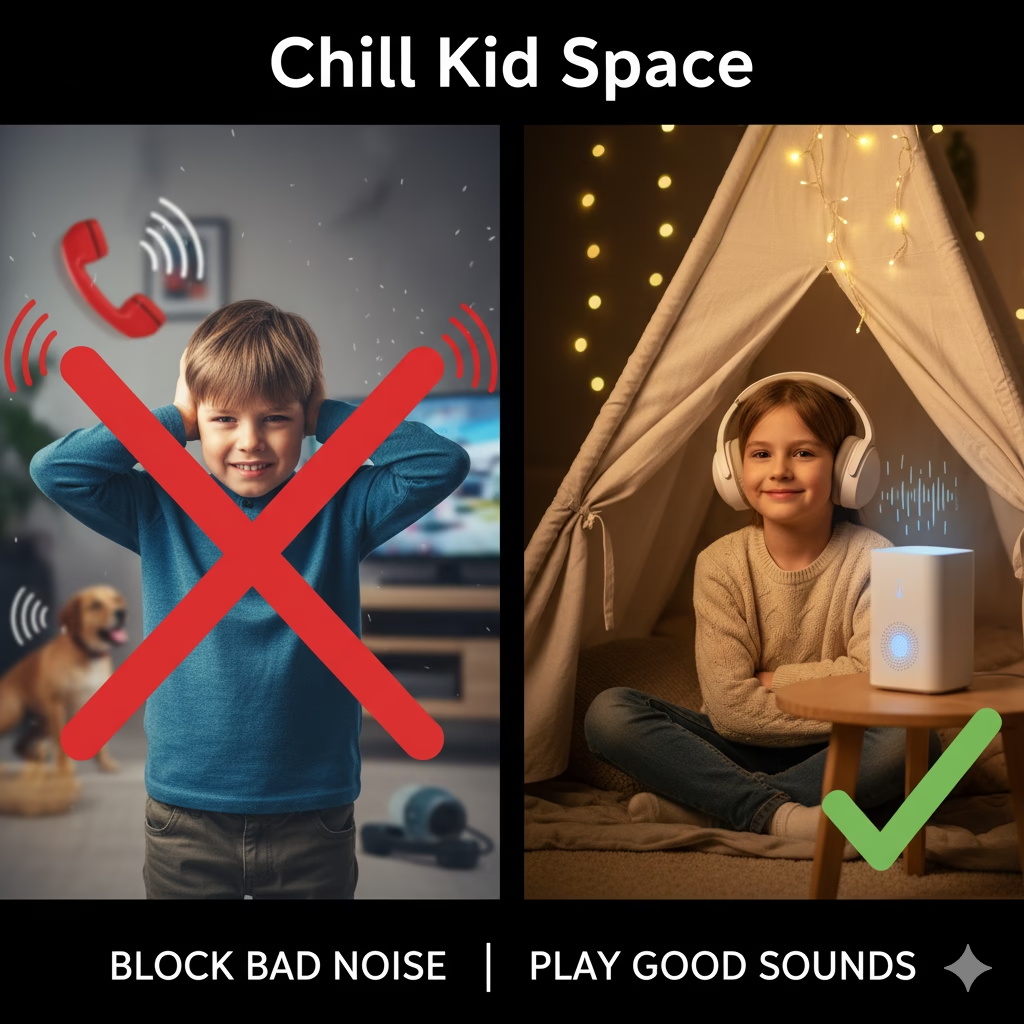
Noise can be a big problem for kids who are stressed. A good Chill Kid Space should either block bad noise or play good, calming sounds.
Simple Calming Sound Tools
- Sound Machines: A good sound machine is a must-have. It can play white noise (a steady sound) to hide distracting household noises. Or, it can play nature sounds like rain or ocean waves, which are steady and relaxing.
- Quiet Time Helpers: For older kids who need to read or focus, use comfortable noise-canceling headphones. They can listen to soft music, an audiobook, or just enjoy total silence.
- Mindful Sounds: You can use a gentle chime or a rain stick when your child enters the space. This sound acts like a little signal that says, “Time to breathe deep and relax.” It makes the space feel like a ritual.
Making it Quieter for your Chill Kid Space
Use fabric to soak up extra noise. A thick rug, soft wall hangings, and big cushions help stop echoes. This makes the space feel instantly quieter and safer for a worried child.
3. Sensory Items for Hands-On Relaxation

Touch is a strong way to help kids calm down. When children use their hands with different textures, it helps them focus on the present moment. This helps release restless energy before it turns into a meltdown.
The Best Cozy Textures for a Chill Kid Space
The space should feel soft and inviting to the touch.
- Heavy Comfort: Use a weighted blanket or a weighted lap pad. The heavy weight feels like a warm, firm hug. This pressure helps turn on the body’s calm response, which is great for anxiety.
- Super-Soft Things: Fill the space with lots of soft things: a furry rug, a chunky-knit blanket, and velvety plush pillows. These different textures give comfort to their hands and body.
- The Big Squish: A large beanbag chair or floor cushion is perfect. When kids flop into it, it shapes to their body. This makes them feel safe, held, and secure.
Toys for Busy Hands
Keep a basket of safe, fun toys that help calm energy:
- Stretching and Squishing: Slime, putty, or play dough are excellent. Kneading and stretching them gives deep input to the hands.
- Simple Fidgets: Include easy-to-use stress balls, fidget cubes, or pop-its. These toys offer small, repeated movements that help a child focus and feel better.
- Natural Play: A small tray with kinetic sand or smooth river stones can be used. It is a gentle, quiet way for kids to let out stress by digging and feeling the textures.
4. Comfy Spots to Get Cozy

This is the heart of the Chill Kid Space. It needs a spot that looks so comfy your child is pulled toward it when they feel upset.
Building the Ultimate Corner for a Chill Kid Space
- The Private Hideout: A teepee tent, a fabric canopy, or a small tunnel gives a child a private, enclosed “cave.” This feels safe and lets them hide away from the busy world.
- Fun Movement: If you have room, a hanging egg chair or a soft swing is wonderful. The gentle rocking or swinging motion helps the brain organize itself. This can quickly lower anxiety.
- The Soft Seat: If you have a wide windowsill, add a cushion to make a window seat. Sitting here to look outside is a very peaceful activity.
- Layer it Up: Always pile on the comfort. Start with a soft rug, add the beanbag or chair, and top it with a blanket and pillows. More layers mean more snuggling options.
5. Fun and Quiet Activities for Mindfulness

The things you put in a Chill Kid Space should be screen-free. They must help the child focus, think quietly, and relax.
Tools for a Quiet Chill Kid Space
- Reading Time: Keep a basket of your child’s favorite books. Reading is a focused, quiet activity. It gives them an escape into a story.
- Art for Feelings: A simple art caddy with paper and crayons helps children show how they feel without talking. Coloring books with patterns are great for helping them focus.
- Breathing Games: Use simple toys to teach deep breathing. A pinwheel that must be gently blown is a fun way to practice slow exhales. A collapsible ball (like a Hoberman Sphere) can be opened and closed to match slow breathing.
- Simple Tasks: A few simple wooden puzzles or building blocks offer a quiet task. This helps the brain shift its focus away from stress.
6. The Rules of the Space: How to Use the Chill Kid Space
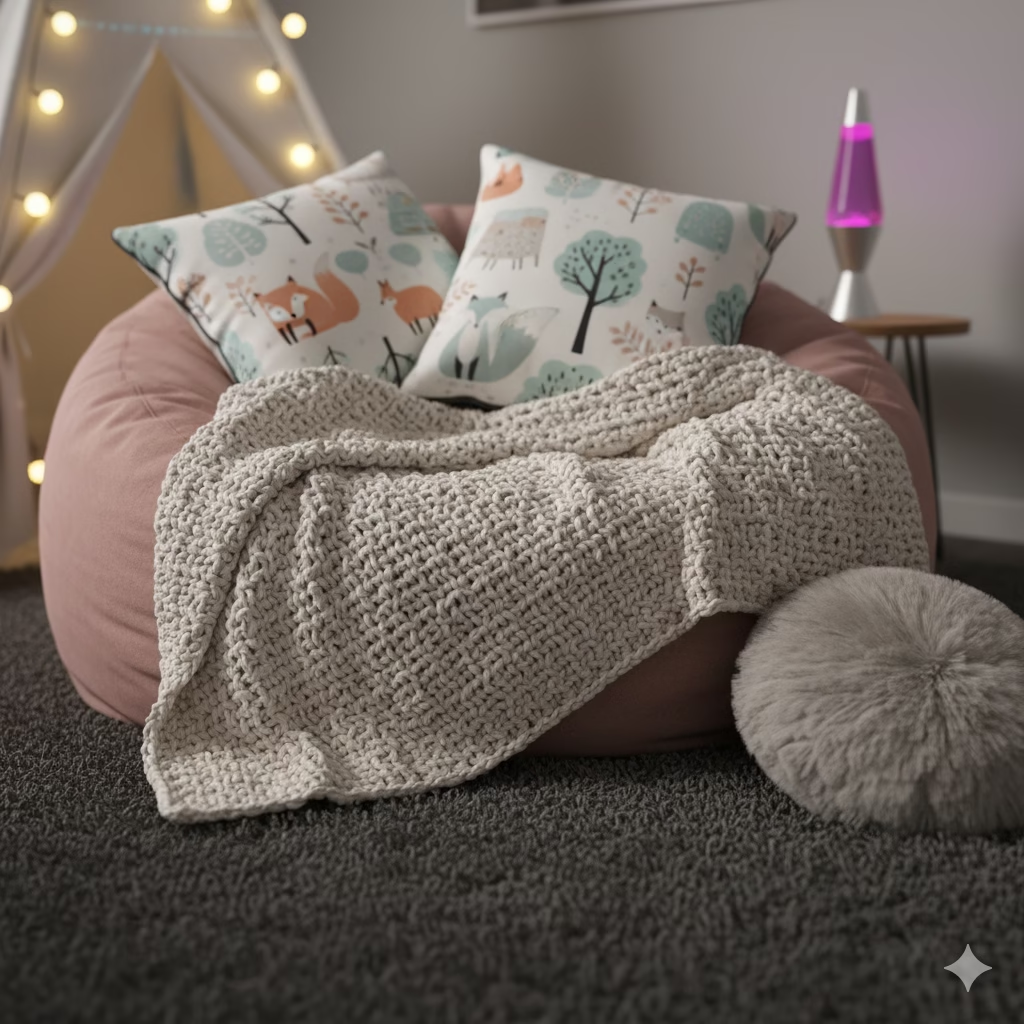
How you use the Chill Kid Space is the most important part. It must be seen as a tool for support, not a place for punishment.
Calling It the “Feel-Better Spot”
- It is NOT Punishment: This is the most vital rule. The Chill Kid Space must NEVER be used as a “timeout.” If you send your child there as a punishment, it will lose its power to help them feel calm. It must stay a place of comfort.
- Practice When Calm: Show your child the space when they are already happy. Sit with them. Read a book. Play with the squishy toys. Model how to take a deep breath. They need to know how to use it when they are upset.
- Teach Them Self-Control: Use positive words. Say, “When your body feels shaky, you can go to your Chill Kid Space,” or “If you are angry, squeeze your stress ball in your Zen Zone.” Let the child choose to use it.
- No Talking Forced: When the child is in the space, let them be quiet. Don’t push them to talk or explain what happened until they come out feeling calm and ready.
7. Putting It All Together: Designing with Care
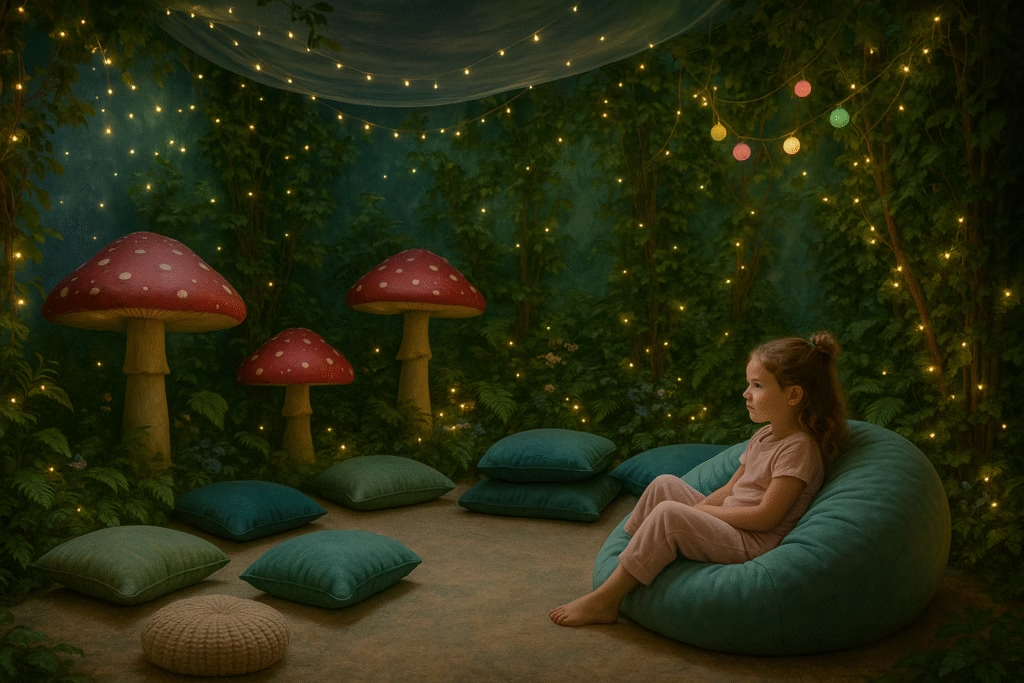
The very best Chill Kid Space is one that is easy to use, clean, and loved by your child.
Keeping It Simple and Clean
The key word is minimalist. A calm space must be clutter-free. Only put in the items that truly help them calm down (the blankets, sensory toys, books). Use small boxes or clean shelves to keep everything neat. Too much clutter is visually loud and ruins the peaceful goal of the space.
Let Them Choose
To make sure your child feels good about using their “chill zone,” let them help choose the items. Let them pick the color of the beanbag or the pattern of the blanket. When they feel like the space belongs to them, they will be much more likely to use it as a helpful tool for their feelings.
By mixing soft colors, useful sensory tools, and a supportive plan, you create more than just a room. You create a powerful tool that teaches your child the lasting skill of finding calm.
References
- MDPI – Healing Spaces as a Design Approach to Optimize
- ScienceDirect – The role of nature in emotion regulation processes
Recent Posts

